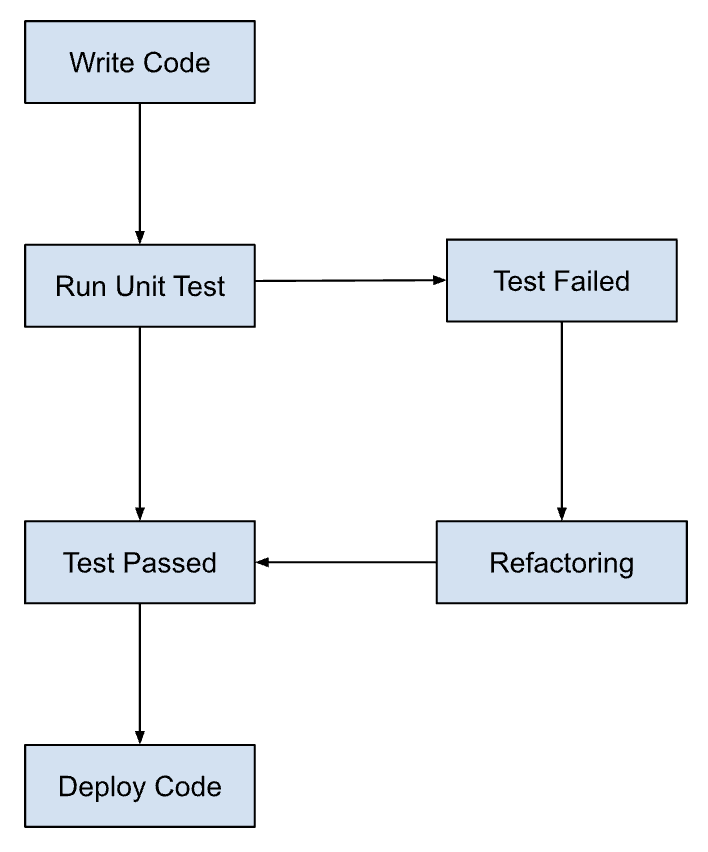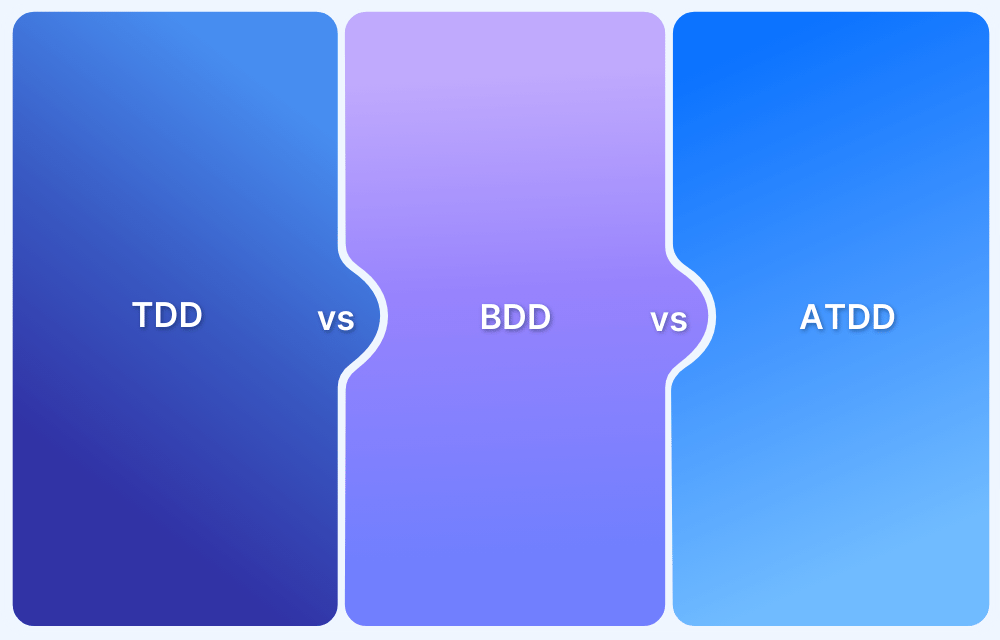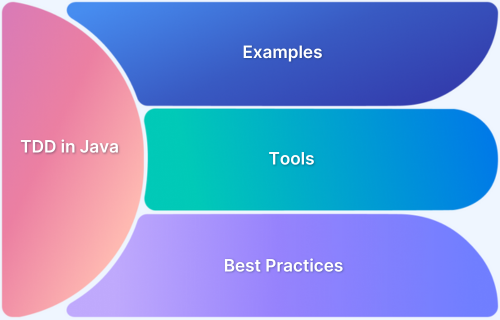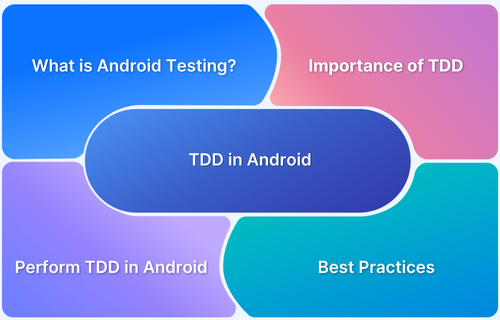TDD allows you to catch bugs early and ensure your code meets requirements. It enforces a test-first approach to help build reliable, maintainable software.
Overview
What is Test-Driven Development (TDD)?
Test-Driven Development (TDD) is a software development process in which tests are written before the actual code. It ensures the code fulfills defined behaviors through short feedback cycles.
What is the TDD Cycle?
It is a simple loop to write reliable and testable code. It includes:
- Red: Write a failing test for the intended behavior
- Green: Write just enough code to make the test pass
- Refactor: Clean up the code while keeping tests green
This article describes the TDD approach in detail, along with its stages, examples, and benefits in software development.
What is Test Driven Development (TDD)?
Test-driven development (TDD) is a software development method in which tests are written before the code. It validates that the code meets defined requirements, keeps the codebase correct and modular, and supports safe, incremental changes throughout development.
The process follows a repetitive cycle known as Red-Green-Refactor.
- Red Phase: First, a developer writes a test that defines a desired feature or behavior (the “Red” phase, as the test will fail initially).
- Green Phase: Then, they write the minimum code necessary to pass the test (the “Green” phase).
- Refactor: Finally, the code is refactored for optimization while ensuring the test still passes.
History of Test Driven Development (TDD)?
Test Driven Development (TDD) evolved over time and gained widespread adoption.
- 1994: Kent Beck develops SUnit, a Smalltalk testing framework, laying the groundwork for test-first practices.
- 1998-2002: The Test First approach evolved into more structured Test Driven Development, and Mock Objects, a key TDD technique, were developed.
- 2003: Kent Beck publishes Test Driven Development: By Example, further popularizing TDD as a core development methodology.
Benefits of Test Driven Development (TDD)
TDD improves code quality, simplifies design, and enhances development efficiency.
- Ensures code correctness: Writing tests first guarantees the code behaves as expected from the outset.
- Encourages simpler design: TDD promotes designing small, focused units of code that are easier to manage and modify.
- Early bug detection: By testing early, you can identify and address bugs immediately, preventing issues from compounding.
- Improves maintainability: A comprehensive suite of automated tests allows for safer code changes and easier updates.
- Boosts developer confidence: Knowing the code is verified through tests helps developers make changes without fear of breaking functionality.
- Facilitates better documentation: The tests document the system’s expected behavior and serve as an up-to-date reference.
Read More: Understanding Testing Documentation
- Faster feedback loop: Immediate feedback from tests accelerates the development cycle and allows for rapid corrections.
Disadvantages of Test Driven Development (TDD)
While TDD offers many benefits, it also has some limitations and challenges.
- Complex tests for complex systems: Writing effective tests for complex or highly integrated systems can be time-consuming and challenging.
- Overemphasis on unit tests: TDD focuses on unit tests, which may overlook integration or system-level testing.
- Potential for incomplete tests: Writing tests for every scenario may be impractical and could lead to incomplete coverage.
Three Phases of Test Driven Development
Test-driven development includes creating precise tests, correcting the code, and refactoring the code. Below is a detailed explanation of the three phases of TDD.
- Create precise tests: Developers need to create exact unit tests to verify the functionality of specific features. They must ensure that the test compiles so that it can execute. In most cases, the test is bound to fail. This is a meaningful failure as developers create compact tests based on their assumptions of how the feature will behave.
- Correcting the Code: Once a test fails, developers must make the minimal changes required to update the code to run successfully when re-executed.
- Refactor the Code: Once the test runs successfully, check for redundancy or any possible code optimizations to enhance overall performance. Ensure that refactoring does not affect the external behavior of the program.
The image below represents a high-level TDD approach toward development:
Test Driven Development (TDD) Examples
Here are some of the examples where TDD is used:
- Calculator Function: When building a calculator function, a TDD approach would involve writing a test case for the “add” function and then writing the code for the process to pass that test. Once the “add” function is working correctly, additional test cases would be written for other functions such as “subtract”, “multiply” and “divide”.
- User Authentication: When building a user authentication system, a TDD approach would involve writing a test case for the user login functionality and then writing the code for the login process to pass that test. Once the login functionality works correctly, additional test cases will be written for registration, password reset, and account verification.
- E-commerce Website: When building an e-commerce website, a TDD approach would involve writing test cases for various features such as product listings, shopping cart functionality, and checkout process. Tests would be written to ensure the system works correctly at each process stage, from adding items to the cart to completing the purchase.
Approaches of Test Driven Development (TDD)
TDD can be implemented using different approaches, each with its own focus and strategy for testing and development.
1. Inside Out Approach
In the Inside Out approach, development begins with the smallest components or core functionality. Tests are written for low-level components such as classes, methods, or individual functions.
Once the core units pass their tests, the development expands outward to higher-level components. This ensures that foundational elements of the system are robust before focusing on integration with other parts of the system.
Here are some benefits of the Inside Out approach:
- Ensures core functionality is correct before expanding to higher-level components.
- Helps build a solid internal structure that reduces the risk of errors as development progresses.
- Allows for easier identification and isolation of issues at the component level.
- Promotes a clear focus on small, manageable parts of the system.
- Leads to more maintainable code with well-tested core components.
2. Outside In Approach
The Outside In approach flips this order by starting with the system’s external interfaces and focusing on features or user-facing behavior. Tests are initially written for higher-level components like user interfaces, APIs or system integrations.
These tests define the expected behavior from an end-user perspective. As the tests fail, developers write the necessary code to meet these behaviors. This approach is often used when the primary focus is on fulfilling customer or user requirements.
Here are some benefits of the Outside In approach:
- Validates user-facing features early to ensure they meet user requirements.
- Ensures the system is designed with end-to-end functionality in mind.
- Helps prioritize user-facing components and integrations early in the development process.
- Provides immediate feedback on user-facing behavior.
- Encourages building the system with real-world use cases in mind.
Frameworks for Test Driven Development
Based on unique programming languages, multiple frameworks support test driven development. Listed below are a few popular ones.
- csUnit and NUnit are open source unit testing frameworks for .NET projects.
- PyUnit and DocTest: Popular Unit testing framework for Python.
- Junit: Widely used unit testing tool for Java
- TestNG: Another popular Java testing framework. This framework overcomes the limitations of Junit.
- Rspec: A testing framework for Ruby projects
TDD Vs. Traditional Testing
- Approach: TDD is an agile development methodology where tests are written before the code is developed. In contrast, traditional testing is performed after the code is written.
- Testing Scope: TDD focuses on testing small code units at a time, while traditional testing covers testing the system as a whole, including integration, functional, and acceptance testing.
- Iterative: TDD follows an iterative process, where small chunks of code are developed, tested, and refined until they pass all tests. The code is usually tested once and then refined based on the results in traditional testing.
- Debugging: TDD aims to catch errors as early as possible in the development process, making debugging and fixing them easier. Traditional testing, on the other hand, may require more effort to debug errors that are discovered later in the development process.
- Documentation: TDD documentation typically focuses on the test cases and their results, while traditional testing documentation may include more detailed information about the testing process, the test environment, and the system under test.
Overall, TDD offers a more efficient and reliable approach to software development, ensuring that code is thoroughly tested before being integrated into the system. Traditional testing, however, may be more appropriate for larger and more complex projects where a more comprehensive approach to testing is required.
How does TDD fit into Agile Development?
Agile development demands regular feedback to develop the expected product. In simple terms, one can also term Agile development as Feedback Driven Development.
There’s a high probability that project requirements may change during the development sprint cycle. To deal with this and to build products aligned with the client’s changing requirements, teams need constant feedback to avoid dishing out unusable software. TDD is built to offer such feedback early on.
TDD’s test-first approach also helps mitigate critical bottlenecks that obstruct the quality and delivery of software. Based on the constant feedback, bug fixes, and the addition of new features, the system evolves to ensure that everything works as intended. TDD enhances collaboration between team members from both the development and QA teams and the client. Additionally, as the tests are created beforehand, teams don’t need to spend time recreating extensive test scripts.
Challenges in Test-Driven Development
TDD provides a structured process but comes with challenges. Here are two key challenges:
1. Fakes, Mocks, and Integration Tests
Unit tests should focus on isolated components but often rely on fakes or mocks when external systems are involved. These tools simulate real system behavior to speed up tests. However, using them may obscure the actual system behavior and require additional integration tests to verify end-to-end functionality.
To address this challenge, developers should use mock and fake objects for isolation but ensure they are complemented with integration tests. The integration tests should verify that real system components work together as expected.
2. Code Visibility
Test code needs access to the code it tests. However, this can conflict with design principles like information hiding and encapsulation. To test private fields or methods, developers may need to use reflection or inner classes, which can lead to design compromises.
To address this, developers can use tools like reflection or partial classes to give tests access to private methods or fields. These solutions should be temporary and excluded from the production code using techniques like conditional compilation. This ensures the test code does not interfere with the production design while still enabling thorough testing.
Best Practices for Test Driven Development (TDD)
Test-driven development (TDD) is a software development practice that emphasizes writing tests before writing the actual code. It follows a cyclical process of writing a failing test, writing the minimum code to make the test pass, and then refactoring the code. Here are some best practices to consider when practicing TDD:
- Start with a clear understanding of requirements: Begin by understanding the requirements or specifications of the feature you are developing. This will help you write focused and relevant tests.
- Write atomic tests: Each test should focus on a specific behavior or functionality. Keep your tests small and focused, addressing a single aspect of the code. This improves test readability, maintainability, and allows for easier debugging.
- Write the simplest test case first: Begin by writing the simplest possible test case that will fail. This helps you focus on the immediate task and avoids overwhelming yourself with complex scenarios upfront.
- Write tests for edge cases: Consider boundary conditions and edge cases when designing your tests. These are inputs or scenarios that lie at the extremes of the input domain and often reveal potential bugs or unexpected behavior.
- Refactor regularly: After a test passes, take time to refactor the code and improve its design without changing its behavior. This helps maintain clean and maintainable code as the project progresses.
- Maintain a fast feedback loop: Your test suite should execute quickly so that you can receive immediate feedback on the health of your code. Fast feedback allows for faster development iterations and catches issues early on.
- Automate your tests: Utilize test automation frameworks and tools to automate the execution of your tests. This enables you to run tests frequently, easily integrate them into your development workflow, and ensure consistent and reliable test results.
- Follow the Red-Green-Refactor cycle: Adhere to the core TDD cycle of writing a failing test (Red), implementing the minimum code to pass the test (Green), and then refactoring the code to improve its design (Refactor). Repeat this cycle for each new behavior or feature.
- Maintain a comprehensive test suite: Aim to achieve a good balance between unit tests, integration tests, and acceptance tests. Each test type serves a different purpose and provides different levels of confidence in the code.
- Continuously run tests: Integrate your test suite with your development environment and set up continuous integration (CI) pipelines to automatically execute tests whenever code changes are made. This ensures that tests are run consistently and helps catch regressions early.
- Test failures should guide development: When a test fails, it should guide your development efforts. Analyze the failure, identify the cause, and fix the code to address the issue. Test failures are valuable feedback for improving code quality.
Why Use Real Device Testing After Test-Driven Development (TDD)?
Real device testing ensures that software behaves as expected in real-world scenarios. While TDD emphasizes writing tests before code, real device testing helps evaluate hardware-specific features, device performance, and compatibility across different devices and operating systems.
After completing development with TDD, real device testing verifies the application’s behavior on real devices to ensure the product meets end-user expectations. BrowserStack helps automate this by allowing developers to integrate it with their CI/CD pipelines.
Here are the key features of BrowserStack Automate:
- Real Device Cloud: Test apps on 3500+ real devices and browsers without needing your own lab.
- Easy Integration: Works with popular CI/CD tools like Jenkins, GitHub Actions, and Azure DevOps to automate testing in your pipeline.
- Parallel Testing: Run multiple tests at the same time to save time and speed up delivery.
- End-to-End Testing: Test everything from functionality to performance and visual consistency.
- Built-in Test Observability: Use AI-driven test analysis and intelligent test reporting to monitor flakiness, text logs, network logs, and other key metrics.
Conclusion
Test-Driven Development provides a structured approach to software development. It focuses on writing tests before code to ensure higher code quality and fewer defects. Despite challenges like code visibility and managing external dependencies, TDD is valuable in Agile environments as it improves collaboration and keeps the focus on user requirements for successful project outcomes.
However, real device testing is necessary to ensure your application works properly in real user scenarios. BrowserStack gives you access to 3,500+ devices, browsers, and OS combinations to test your application in different environments. Run tests in parallel, and provide real-time feedback to ensure that developers can maintain high test coverage across multiple environments.
Frequently Asked Questions
1. Why is it important to see a test fail?
A failing test in TDD confirms that the test is working as expected and ensures the code meets the desired behavior. It highlights incomplete functionality and guides developers to fix issues. This helps maintain a robust development cycle by preventing defects early on.








